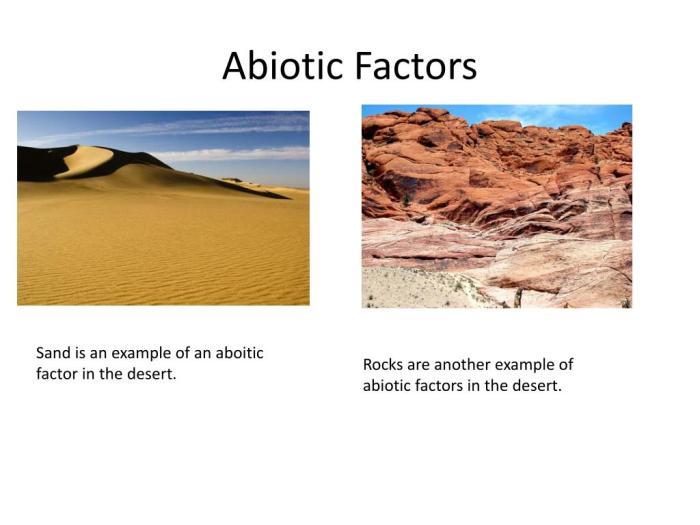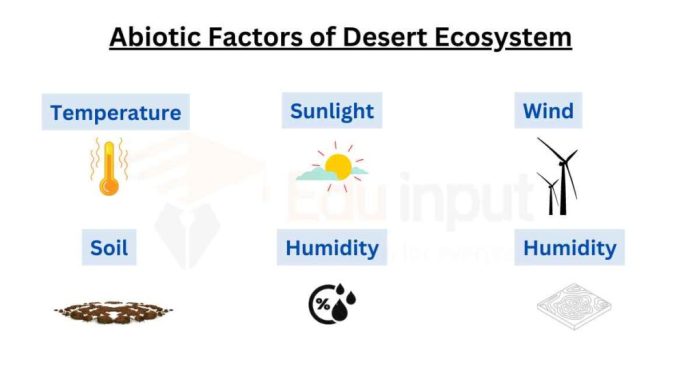The biotic factors of the desert biome, encompassing its diverse flora, fauna, and microorganisms, paint a captivating portrait of life’s resilience and adaptability in extreme environments. This discourse delves into the intricate relationships, adaptations, and ecological roles of these organisms, unraveling the complexities of a seemingly desolate landscape.
Within the arid embrace of the desert, a myriad of biotic factors engage in a dynamic interplay, shaping the ecosystem’s intricate tapestry. Plants and animals have evolved remarkable adaptations to endure the harsh conditions, while their interactions form a web of interdependence that sustains the fragile balance of life.
Biotic Factors of the Desert Biome

The desert biome is characterized by extreme conditions, including high temperatures, low precipitation, and limited water availability. Biotic factors refer to the living organisms that inhabit this unique ecosystem, including plants, animals, and microorganisms.
Biotic factors play a crucial role in shaping the structure and functioning of the desert biome. They interact with each other and the abiotic factors (non-living components) to create a complex and dynamic ecosystem.
Interactions between Biotic Factors, Biotic factors of the desert biome
Biotic factors interact with each other in various ways, including:
- Symbiotic relationships:Mutualism, commensalism, and parasitism are common symbiotic relationships found in the desert biome.
- Competition:Limited resources, such as water and food, lead to competition among species for survival.
- Predation:Predators rely on prey for food, shaping the population dynamics and behavior of both predators and prey species.
Adaptations of Biotic Factors to Desert Conditions
Plants and animals in the desert biome have evolved unique adaptations to survive the harsh conditions:
- Drought tolerance:Plants have developed mechanisms to conserve water, such as thick cuticles, deep root systems, and reduced leaf surface area.
- Water conservation mechanisms:Animals have physiological adaptations to reduce water loss, such as concentrated urine, nocturnal activity, and the ability to store water in their bodies.
- Nocturnal activity:Many animals are nocturnal to avoid the extreme heat and conserve water during the day.
Distribution and Abundance of Biotic Factors
The distribution and abundance of biotic factors vary across different desert regions:
- Temperature:Temperature gradients influence the distribution of species, with some species adapted to specific temperature ranges.
- Precipitation:Areas with higher precipitation support a greater diversity and abundance of biotic factors.
- Soil conditions:Soil type and nutrient availability affect the distribution and abundance of plants and the animals that depend on them.
| Desert Biome | Key Species | Distribution | Abundance |
|---|---|---|---|
| Sahara Desert | Sahara cypress | Scattered throughout the desert | Moderate |
| Sonoran Desert | Saguaro cactus | Southern Arizona and northwestern Mexico | High |
| Atacama Desert | Atacama mouse | Coastal areas of northern Chile | Moderate |
Role of Biotic Factors in Ecosystem Function
Biotic factors play a vital role in maintaining the stability and functioning of the desert ecosystem:
- Nutrient cycling:Plants and animals contribute to nutrient cycling through decomposition and the release of organic matter into the soil.
- Energy flow:Food chains and food webs transfer energy from producers to consumers and decomposers.
- Regulation of ecosystem processes:Biotic factors influence processes such as water cycling, soil formation, and the maintenance of ecosystem balance.
Expert Answers: Biotic Factors Of The Desert Biome
What are the key biotic factors found in desert biomes?
Biotic factors in desert biomes include a wide range of plants, animals, and microorganisms adapted to the arid conditions, such as drought-tolerant vegetation, burrowing mammals, and specialized insects.
How do biotic factors interact within desert biomes?
Biotic factors interact through various relationships, including competition for resources, symbiotic partnerships, and predator-prey dynamics, contributing to the overall ecosystem balance.
What are some unique adaptations of plants and animals in desert biomes?
Plants in desert biomes have evolved adaptations such as deep root systems, waxy leaves, and CAM photosynthesis to conserve water, while animals exhibit adaptations like nocturnal activity, burrowing behaviors, and efficient water utilization.
